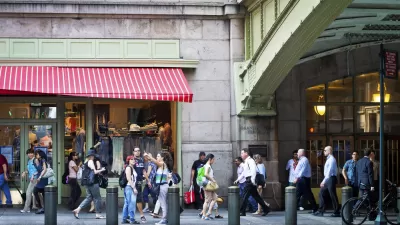By comparing the city's density, scale, and distribution of employment nodes to other major cities, Kristin Eberhard makes the case for why and how transit can work in big, dense, polycentric Los Angeles.
"LA faces a public transit challenge," says Eberhard. "How to connect a disperse, evenly dense population with multiple jobs centers and residential areas in a seamless way that is competitive with cars? My answer: we can’t just do what other cities do and hope for the best."
She details how L.A.'s structure compares to other transit rich cities, and explains the three key attributes for building an effective public transit system for the city:
- We need a grid, not a spiderweb: "LA needs to cover a broad territory fairly evenly so that residents can get not just to a single downtown destination, but pretty much everywhere in the region."
-
We need better first-mile / last-mile solutions: "Most people walk to transit, so streets need to be walkable, but they also need to be bikable, scooterable, and neighborhood EV-able (speed-limited to 25 mph so that it is only suitable for neighborhood streets) to really give everyone a good option."
-
We need to have an ecosystem of options: "A combination of carpooling, biking, taking the bus, or driving an EV to a transit hub could vastly improve LA's transportation problems. LA’s solution needs to create an ecosystem where everyone has many options."
FULL STORY: How can transit work in big, dense, polycentric Los Angeles?

Planetizen Federal Action Tracker
A weekly monitor of how Trump’s orders and actions are impacting planners and planning in America.

Chicago’s Ghost Rails
Just beneath the surface of the modern city lie the remnants of its expansive early 20th-century streetcar system.

San Antonio and Austin are Fusing Into one Massive Megaregion
The region spanning the two central Texas cities is growing fast, posing challenges for local infrastructure and water supplies.

Since Zion's Shuttles Went Electric “The Smog is Gone”
Visitors to Zion National Park can enjoy the canyon via the nation’s first fully electric park shuttle system.

Trump Distributing DOT Safety Funds at 1/10 Rate of Biden
Funds for Safe Streets and other transportation safety and equity programs are being held up by administrative reviews and conflicts with the Trump administration’s priorities.

German Cities Subsidize Taxis for Women Amid Wave of Violence
Free or low-cost taxi rides can help women navigate cities more safely, but critics say the programs don't address the root causes of violence against women.
Urban Design for Planners 1: Software Tools
This six-course series explores essential urban design concepts using open source software and equips planners with the tools they need to participate fully in the urban design process.
Planning for Universal Design
Learn the tools for implementing Universal Design in planning regulations.
planning NEXT
Appalachian Highlands Housing Partners
Mpact (founded as Rail~Volution)
City of Camden Redevelopment Agency
City of Astoria
City of Portland
City of Laramie





























